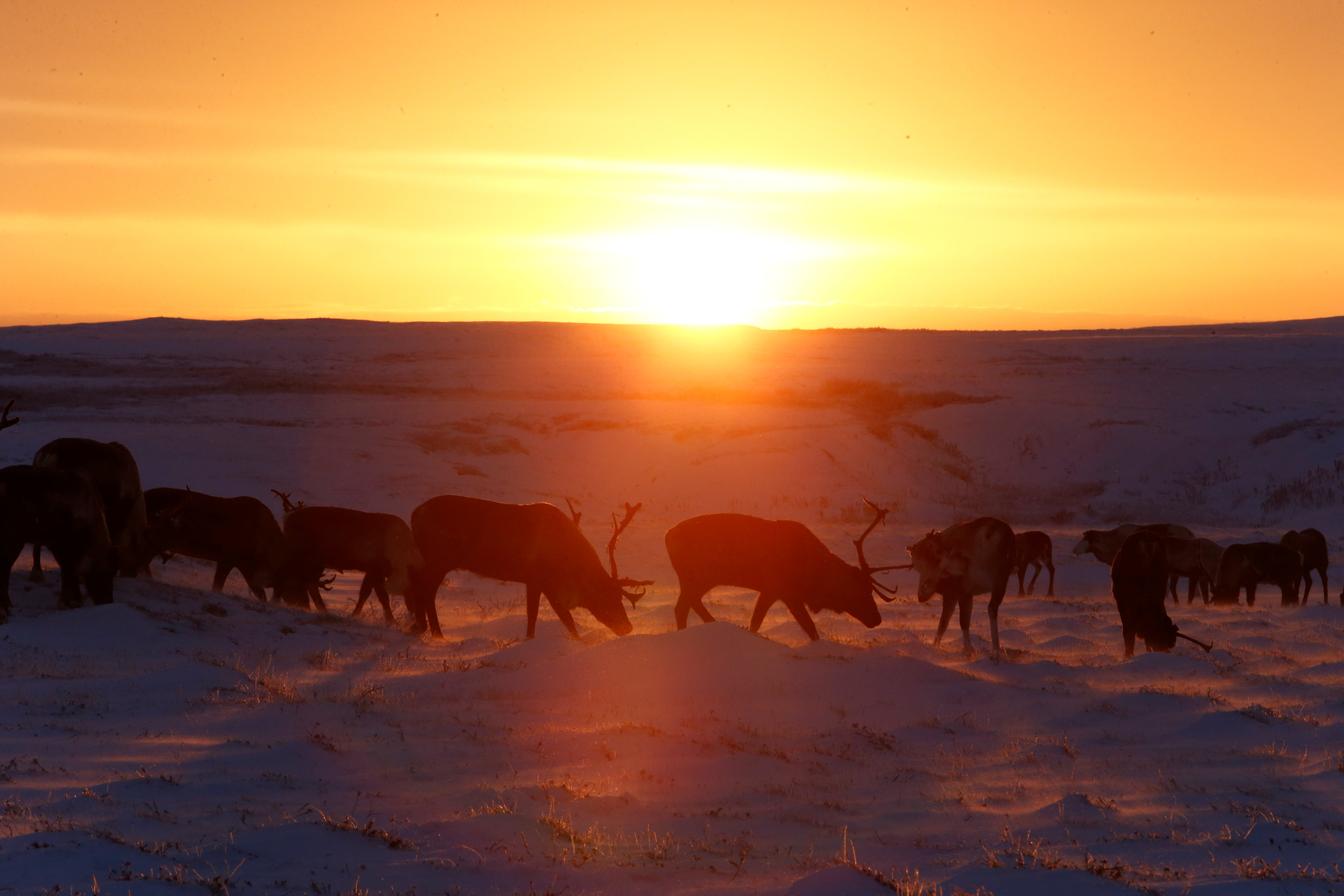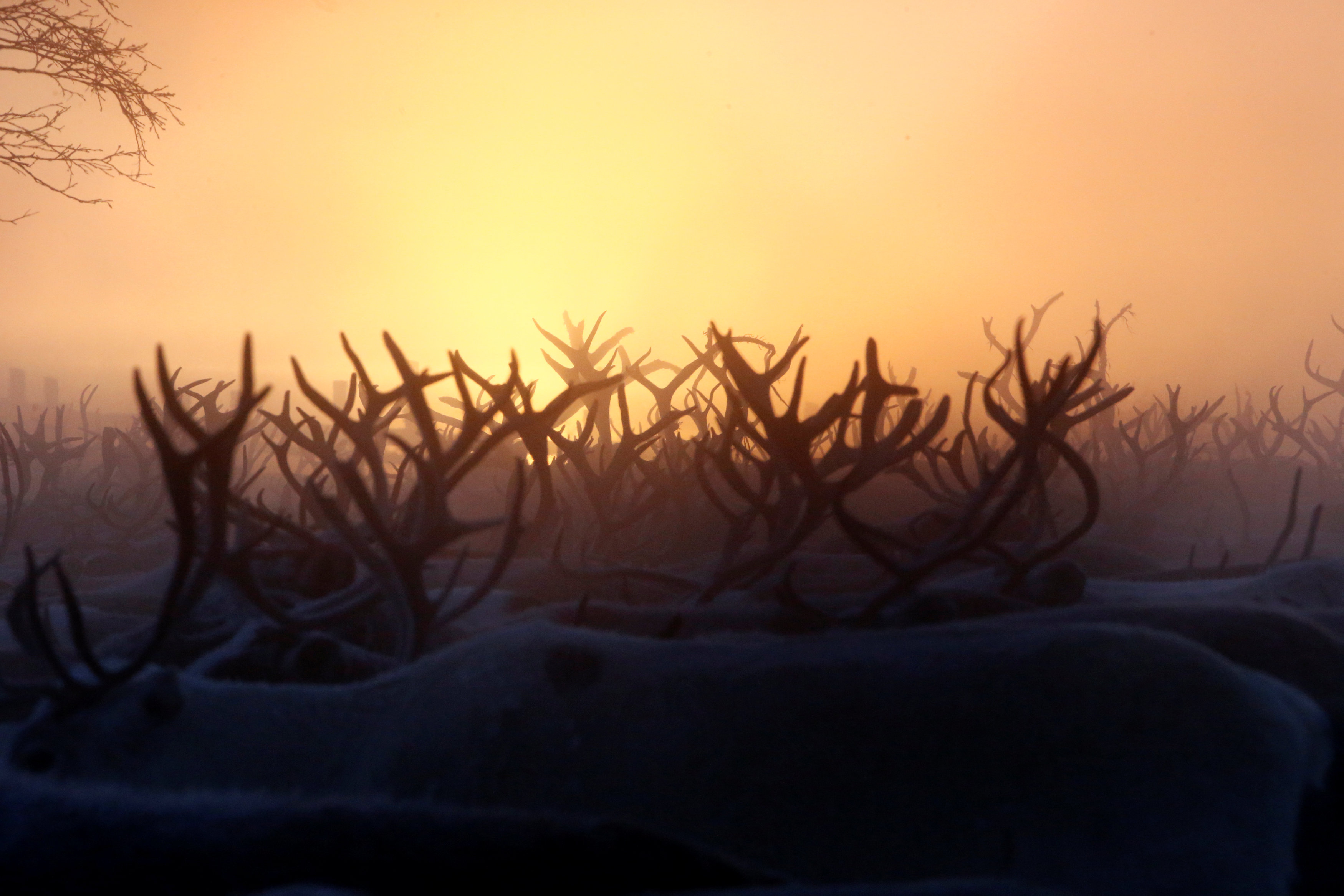At Chukotka’s first congress of reindeer herders in 15 years, an optimistic view of the future

On Saturday, March 4, an uncommon event took place in the village of Amguema: For the first time since 2002, reindeer herders from all over Chukotka gathered to discuss the results and prospects of developing subsistence management which is crucial to the district.
Dozens of workers from reindeer farms, from top management to frontline tundra workers, participated in the fifth congress of reindeer herders, which was a part of the “Erak’or-2017” Fair.
The congress of reindeer herders was held in a small, cozy Cultural Center of Amguema village. In the opening session, Anna Otke, the president of the Association of Indigenous Peoples, addressed the audience and acted as one of the organizers of the rally of reindeer herders.
“The reindeer herders’ congress has not taken place for more than 10 years, and we felt that it was necessary to establish a productive dialogue between reindeer herders and state authorities,”Otke said. “It is very good that the District’s Department of Industrial and Agricultural Policy has willingly responded to our request, and such a dialogue will take place today.”
The head of the District’s Agricultural Department, Sergey Davidyuk, addressed the delegates and guests with an expanded report on the topic “On the state of reindeer herding in the Chukotka Autonomous Okrug and measures for its development in the coming years.”
According to Davidyuk, since the fourth congress of Chukotka reindeer herders, which took place in 2002 in Bilibino, a number of significant changes occurred in the industry. As a result of increasing governmental support of the industry through the priority national project “Development of the Agricultural Industrial Complex” and through regional programs, an industry crisis has passed. The total number of reindeer in the farms of the district increased by about 60 percent, from 94,000 in 2002 to 150,000 thousand in 2016.
A careful look at the statistics shows that the dynamics of growth differed significantly from farm to farm. However, the same statistics says that almost all Chukotka farms have increased their livestock counts over the past 15 years, and only in recent years, along with the beginning of industrial slaughter in the district and the increase in the production of reindeer, the number of herds in reindeer farms has slightly decreased.
Government support for reindeer farming in 2017 will amount to 934.2 million rubles. The amount of governmental allocations to the reindeer herding industry has steadily increased within the last 15 years. According to the Department of Industrial and Agricultural Policy of the Chukotka Autonomous District, in 2002 it amounted to 210.9 million rubles, increasing by 2010 to 358.8 million rubles. From 2002 to 2016, governmental support of the northern reindeer herding in the Chukotka region increased 4.4 times.

Help from an iron horse
Davidyuk recalled that the industry’s shift toward a positive development path was also made possible due to the renewal of the machine and tractor fleet in 2002-2004. During that short period of time, the district’s farms received 60 tractors (mostly medium marsh-boats of various modifications based on DT-75), 69 all-terrain vehicles (including 9 TRACKOLs), 24 Ural trucks, and 120 snowmobiles. These purchases significantly contributed to production growth. However, by 2010, a significant portion of these vehicles have reached their useful life, about 50 percent of the equipment has failed or needed major repairs.
A new round of technical re-equipment of reindeer farms began five years ago and continues to the present. 138 units of machinery (tractors, snow-mobile vehicles, snowmobiles, ATVs) and 47 sets of communication equipment (shortwave radio stations, mobile and fixed radio stations, antennas, handheld power generators) were purchased in 2012-2015 for the use by the reindeer farms.
2014 was marked by the allocation of funding from the federal budget to support the socio-economic development of indigenous peoples of the North, Siberia and the Far East. Chukotka used that funding to purchase supplies and equipment for the construction of two basecamps along the routes of reindeer-breeding brigades, as well as overalls, household appliances, and communication equipment for 39 brigades. This equipment and supplies were delivered to the district during 2014 and 2015 navigable seasons and further distributed to brigades.
Finally, in 2016, another 17 units of tractor equipment were purchased using funds from the district’s budget and with federal support for reindeer farming enterprises. Its delivery to the district is planned during the 2017 navigational season.
Incentivizing with bonuses
With the material and technical re-equipment of industry enterprises, consistent efforts have been put toward increasing the salaries of reindeer breeders. It’s no secret that the salaries in the deer breeding industry are still below average in the district. At the same time, thanks to the decisions taken by the district government in 2015-2016, the average wage of workers of reindeer breeding enterprises increased by 52.9 percent and reached 40,600 rubles. The average salary of workers engaged directly in the work in the tundra was about 37,000 rubles.
Another innovation of recent years has been the introduction of a bonus system for reindeer herders that took into account performance against planned targets. As previously reported by Dalniy Sever, the average bonus within the district’s farms for 2016 was 109,700 rubles per person.
“The reindeer herder bonus system has been used in Chukotka for the third year,” said First Deputy Governor Leonid Nikolaev during the congress. “It is very simple and transparent. There are planned indicators for the number of animals. If they are carried out, the reindeer breeders are entitled to a bonus. In addition to reindeer herders, from the end of last year we also began to reward administrative and management personnel. But reindeer herders receive a bonus based on the results of the work of a particular brigade, because there are several brigades in every farm and their results could be different. But the administrative and management personnel are awarded the bonus on the basis of the work of the whole enterprise, as they are responsible for the activities of the farm as a whole. We believe that this is fair.”
Taking into account the fact that each team is responsible for its own results, the size of bonuses for reindeer herders can be significantly different. Thus, 12 employees of one of the leading brigades of the Amguema farm received about 7.4 million rubles in annual bonuses, while for teams that produced worse results, the amount of premiums was several times lower.
“I tell my employees, you will work well, and you will get a decent salary,” says Anatoly Tyneru, director of the Amguema farm. “I will give a simple example. In our farm, a woman from Neshkan has conscientiously worked for two years as a simple laborer. Her earnings were enough to buy a two-room apartment in Amguema, where housing shortages are well-known.”
According to Nikolaev, the differentiated approach to pay, which is focused on stimulating effective employees, did not immediately begin to bear fruit. The first year people were not sufficiently aware of the new bonus system. Now the numbers of workers who are interested in the final results of their work and who understand its connection with the level of wages are becoming greater and greater.
Deer and losses
At the same time, despite all the measures taken to support the industry, most of the reindeer herding enterprises in Chukotka are not yet able to reach the targets, although in general the dynamics of the last three years are positive. Plans for 2016 to increase the number of livestock and production of deer for slaughter were fulfilled by 95.6 percent and 98.4 percent, respectively. The output of livestock in the last year amounted to 150,751 heads with a plan of 157,707 heads, and the production of deer for slaughter — 1,180.7 tons instead of the planned 1,200 tons.
If we perform analysis on the farm level, then six of the district’s farms fulfilled the target indicators for the output and five did so for meat production for slaughter. In another important criterion, the female livestock, the plan was met by only two farms, the Kanchalansky Municipal Unitary Enterprise (MUP) and the Pioneer MUP.
According to the heads of enterprises and representatives of department responsible for reindeer herding, the largest scourge for the industry is high unproductive wastes (due to death from diseases and starvation, and attacks by wild animals). According to the Department of Industrial and Agricultural Policy, in the last three years alone, 56,800 heads were lost in excess of the plan, which in cost terms is astronomical: 468.9 million rubles. The greatest losses — 26,500 — came in 2014. In the last two years, however, this indicator has been declining, amounting to 12,700 heads in 2016. The main areas where the reindeer breeding industry can improve efficiency, specialists say, is the reduction of unproductive losses, and the development of deep processing of reindeer breeding products.
Looking forward
Based on the results of the congress, the delegates formulated recommendations on measures for the further development of reindeer farming in the district. They, in particular, note that “recently, thanks to financial support from the district budget, it was possible to stabilize and stop the decline in livestock. Reindeer farms adapted to new economic conditions, deep reindeer processing is being introduced, the material base of reindeer farming is being strengthened … Reindeer herders’ wages are actually rising, the farms are equipped with snowmobiles and ATVs, tractor equipment, the issues of providing reindeer herders with weapons are being addressed better, housing and utility complexes (basecamps) started to be utilized, the system of guaranteed health resort treatments of reindeer herders is being restored … “.
At the same time, delegates pointed out the inadequacy of state support measures to combat predators, regulate the number of wild reindeer, and to finance research. It was separately noted in the recommendations that “the economic efficiency of reindeer farming is not yet at the proper level, some of the farms are unprofitable, and the proceeds from the sale of reindeer products do not cover operating costs, which significantly impedes the economy and traditional economic activities of the indigenous small peoples of the North.”
Taking this position into account, the delegates formulated a number of recommendations addressed to the Government and the Duma of the Chukotka Autonomous District, local self-government bodies, heads and specialists of reindeer farms, the regional Union of Reindeer Herders, and the Association of Indigenous Peoples of Chukotka.
This article was first published by Krayniy Sever and is republished here by permission.
Correction: An earlier version of this article mis-identified the original publisher as “Dalniy Sever.” This post has been updated to correct the identification.